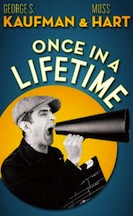ONCE IN A LIFETIME IS A ROMP FOR AN ERA
When the “talkies” trumpeted a new era in American living rooms, a bevy of entertainers stampeded to get in on the ground floor of this opportunity, at all costs. This fertile field for comedy and playful jabs at the industry was harvested by Moss Hart and George S. Kaufman in their first collaboration, 1930’s Once in a Lifetime, wittily weaving fun, satire, opulence and even a prescience that allows for sly commentary on the newest fads of decades in the future.
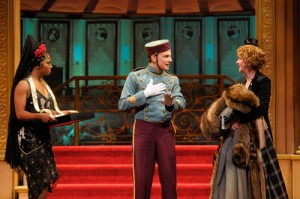 All of this hilarity is found in American Conservatory Theatre’s ambitious production, which has viewers guffawing to the very end, particularly thespians who recognize affectionate reflections of themselves at some early point in their careers. Based on all the chortling on opening night, it’s clear that familiarity breeds laughter.
All of this hilarity is found in American Conservatory Theatre’s ambitious production, which has viewers guffawing to the very end, particularly thespians who recognize affectionate reflections of themselves at some early point in their careers. Based on all the chortling on opening night, it’s clear that familiarity breeds laughter.
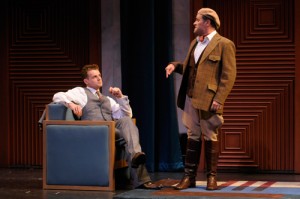 Several factors make this production almost picture perfect, in spite of its nearly two-and-a-half hours running time. Director Mark Rucker fulfills a boyhood dream of leading this play, unleashing 15 actors who capably cover 70 roles. We begin with a washed-up vaudeville trio cooking up a creative con — an elocution school to teach silent-film actors how to speak “properly” in order to grab the brass ring of the burgeoning talkies.
Several factors make this production almost picture perfect, in spite of its nearly two-and-a-half hours running time. Director Mark Rucker fulfills a boyhood dream of leading this play, unleashing 15 actors who capably cover 70 roles. We begin with a washed-up vaudeville trio cooking up a creative con — an elocution school to teach silent-film actors how to speak “properly” in order to grab the brass ring of the burgeoning talkies.
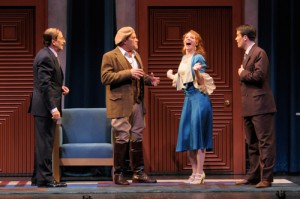 Julia Coffey grounds the story as the sardonic, level-headed, yet appealing May Daniels. John Wernke brings balance as May’s love interest, Jerry Hyland, giddily swept up in the new art form to the point of dropping his buddies when opportunity knocks, only to be embraced by them in the end. Rounding off the trio is Patrick Lane’s George Lewis, a character more endearing than bright, but ultimately a hapless hero in spite of himself.
Julia Coffey grounds the story as the sardonic, level-headed, yet appealing May Daniels. John Wernke brings balance as May’s love interest, Jerry Hyland, giddily swept up in the new art form to the point of dropping his buddies when opportunity knocks, only to be embraced by them in the end. Rounding off the trio is Patrick Lane’s George Lewis, a character more endearing than bright, but ultimately a hapless hero in spite of himself.
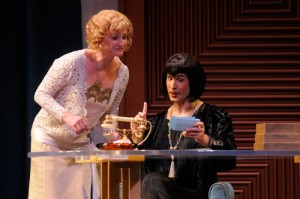 Rucker’s innovative staging begins with limited use of the space during the first two acts, so the audience will feel it is looking at a talkie in a small rectangular room. One clever set utilizes a Hollywood-bound Pullman car on which the leading characters ride, their realistic rocking motion further drawing us into the story. But in the third act, the production wisely spreads to the full stage, as our heroes move into the world of movies in a suitably opulent set (scenery by Daniel Ostling).
Rucker’s innovative staging begins with limited use of the space during the first two acts, so the audience will feel it is looking at a talkie in a small rectangular room. One clever set utilizes a Hollywood-bound Pullman car on which the leading characters ride, their realistic rocking motion further drawing us into the story. But in the third act, the production wisely spreads to the full stage, as our heroes move into the world of movies in a suitably opulent set (scenery by Daniel Ostling).
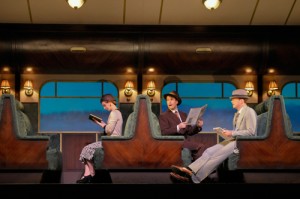 From curtain up to curtain call, we experience Hollywood’s uncertain merry-go-round of opportunity, disaster, and colorful characters. Just about everyone snaps into an immediate audition every time a director passes by. There are also parodies of luminaries from the time, such as movie authority and coveted Variety critic, Helen Hobart, played with warm nostalgia by Rene Augesen.
From curtain up to curtain call, we experience Hollywood’s uncertain merry-go-round of opportunity, disaster, and colorful characters. Just about everyone snaps into an immediate audition every time a director passes by. There are also parodies of luminaries from the time, such as movie authority and coveted Variety critic, Helen Hobart, played with warm nostalgia by Rene Augesen.
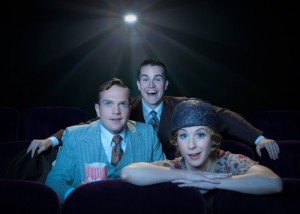 Other stand-outs include Will LeBow as harried director Herman Glogauer, aching to recover the fame that slipped through his fingers when he passed up the Vitaphone; Nick Gabriel – a master of the comedic pause – in credible drag as receptionist Miss Leighton, whose derisive persona is unfazed by craziness; a winsome Ashley Wickett as George’s girlish love interest with stars in her eyes and her eyes on the stars; Alexander Crowther as luckless playwright Lawrence Vail, who winds up in an asylum after a breakdown caused by lack of work; and Kevin Rolston as habit-clad director Rudolph Kammerling, a delightfully bombastic character with a nearly flawless German accent.
Other stand-outs include Will LeBow as harried director Herman Glogauer, aching to recover the fame that slipped through his fingers when he passed up the Vitaphone; Nick Gabriel – a master of the comedic pause – in credible drag as receptionist Miss Leighton, whose derisive persona is unfazed by craziness; a winsome Ashley Wickett as George’s girlish love interest with stars in her eyes and her eyes on the stars; Alexander Crowther as luckless playwright Lawrence Vail, who winds up in an asylum after a breakdown caused by lack of work; and Kevin Rolston as habit-clad director Rudolph Kammerling, a delightfully bombastic character with a nearly flawless German accent.
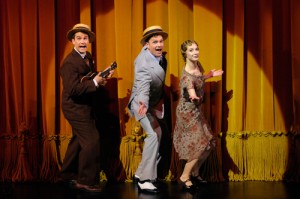 The golden trim of the theater’s soaring space adds to the ambiance of the 1930s and Alex Jaeger’s costuming brings a visually rich palette and sense of period, with spot-on detail. Sounds of crunching add whimsy, popping along with actors’ voices — a fitting aural metaphor of George’s love of India nuts (sound by Cliff Caruthers). Major kudos goes to the use of multimedia: scenes start with film clips, some authentic and others convincingly made to look that way, creating historic or humorous tones as necessary (video design by Alexander V. Nichols).
The golden trim of the theater’s soaring space adds to the ambiance of the 1930s and Alex Jaeger’s costuming brings a visually rich palette and sense of period, with spot-on detail. Sounds of crunching add whimsy, popping along with actors’ voices — a fitting aural metaphor of George’s love of India nuts (sound by Cliff Caruthers). Major kudos goes to the use of multimedia: scenes start with film clips, some authentic and others convincingly made to look that way, creating historic or humorous tones as necessary (video design by Alexander V. Nichols).
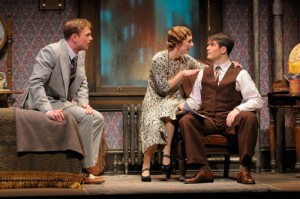 The show emerges as a commentary, wrapped in riffs on theatrical history and human foibles. In an accidentally serendipitous moment, George purchases hundreds of airplanes, and against all odds it turns out to be a savvy business decision. Similarly, looking at the young woman pictured in the program (as a 1929 Photoplay ad), who speaks with urgency into “the microphone, the terror of the studio,” it is easy to think of the allure of the iPad; new today, even more new tomorrow.
The show emerges as a commentary, wrapped in riffs on theatrical history and human foibles. In an accidentally serendipitous moment, George purchases hundreds of airplanes, and against all odds it turns out to be a savvy business decision. Similarly, looking at the young woman pictured in the program (as a 1929 Photoplay ad), who speaks with urgency into “the microphone, the terror of the studio,” it is easy to think of the allure of the iPad; new today, even more new tomorrow.
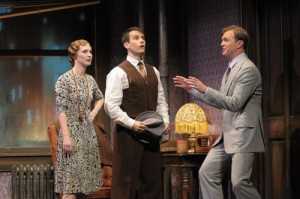 But despite its prescient elements, this production discourages wasting too much time in silent speculation in favor of audible laughter – and what director Rucker calls a “loving look at that craziness.” Now that’s what we’re talking about.
But despite its prescient elements, this production discourages wasting too much time in silent speculation in favor of audible laughter – and what director Rucker calls a “loving look at that craziness.” Now that’s what we’re talking about.
strevenon @ stageandcinema.com
photos by Kevin Berne
Once in a Lifetime
American Conservatory Theatre in San Francisco
scheduled to end on October 16
for tickets, visit http://www.act-sf.org/
